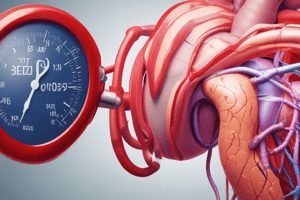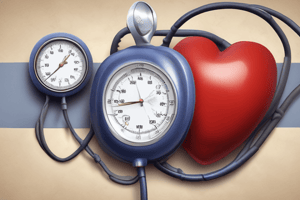Podcast
Questions and Answers
What is the direct effect of the atrial volume (Gauer-Henry) reflex?
What is the direct effect of the atrial volume (Gauer-Henry) reflex?
- Decrease heart rate
- Increase vasoconstriction
- Adjusting salt and water excretion rate through the kidney (correct)
- Increase blood viscosity
Where are the receptors for the peripheral arterial baroreflex primarily located?
Where are the receptors for the peripheral arterial baroreflex primarily located?
- Lungs and diaphragm
- Kidneys and liver
- Aortic arch and carotid sinus (correct)
- Brainstem and spinal cord
Which of these is an example of short-term blood pressure regulation?
Which of these is an example of short-term blood pressure regulation?
- Renin-angiotensin II system
- Stress-relaxation response
- Peripheral arterial baroreflex (correct)
- Pressure diuresis
During the intermediate-term regulation of ABP, what two factors does the body regulate?
During the intermediate-term regulation of ABP, what two factors does the body regulate?
What is the primary outcome of stimulating the medullary reticular formation during the abdominal compression reflex?
What is the primary outcome of stimulating the medullary reticular formation during the abdominal compression reflex?
What duration characterizes short-term blood pressure regulation mechanisms?
What duration characterizes short-term blood pressure regulation mechanisms?
What is the role of the efferent nerve in the peripheral arterial baroreflex?
What is the role of the efferent nerve in the peripheral arterial baroreflex?
In response to increased arterial blood pressure, what is directly inhibited by activated baroreceptors?
In response to increased arterial blood pressure, what is directly inhibited by activated baroreceptors?
Which condition triggers the CNS ischemic response?
Which condition triggers the CNS ischemic response?
What is the correct formula for determining Mean Arterial Blood Pressure (MAP)?
What is the correct formula for determining Mean Arterial Blood Pressure (MAP)?
What is the stimulus that activates the aortic and carotid chemoreceptors?
What is the stimulus that activates the aortic and carotid chemoreceptors?
Through what mechanism does the 'stress-relaxation' mechanism primarily correct ABP?
Through what mechanism does the 'stress-relaxation' mechanism primarily correct ABP?
Which mechanism increases the release of noradrenaline from sympathetic postganglionic nerve endings?
Which mechanism increases the release of noradrenaline from sympathetic postganglionic nerve endings?
Which of the following reflexes results in a decrease in heart rate?
Which of the following reflexes results in a decrease in heart rate?
What is systemic blood pressure?
What is systemic blood pressure?
What is the primary action of the capillary fluid shift mechanism in response to increased arterial blood pressure?
What is the primary action of the capillary fluid shift mechanism in response to increased arterial blood pressure?
What event directly follows 'Renal ischemia stimulates renin secretion from JGC'?
What event directly follows 'Renal ischemia stimulates renin secretion from JGC'?
What best describes long term blood pressure regulation?
What best describes long term blood pressure regulation?
What is the main determinant of blood pressure in long-term regulation?
What is the main determinant of blood pressure in long-term regulation?
How would you define 'pulse pressure'?
How would you define 'pulse pressure'?
Flashcards
Arterial Blood Pressure (ABP)
Arterial Blood Pressure (ABP)
The lateral pressure exerted by the column of blood on the wall of arterial system.
Systolic Blood Pressure (SBP)
Systolic Blood Pressure (SBP)
The peak pressure in the arteries during ventricular contraction (systole).
Diastolic Blood Pressure (DBP)
Diastolic Blood Pressure (DBP)
The minimum pressure in the arteries during ventricular relaxation (diastole).
Pulse Pressure
Pulse Pressure
Signup and view all the flashcards
Mean Arterial Pressure (MAP)
Mean Arterial Pressure (MAP)
Signup and view all the flashcards
Short-Term ABP Regulation
Short-Term ABP Regulation
Signup and view all the flashcards
Intermediate ABP Regulation
Intermediate ABP Regulation
Signup and view all the flashcards
Long-Term ABP Regulation
Long-Term ABP Regulation
Signup and view all the flashcards
Arterial Baroreflex
Arterial Baroreflex
Signup and view all the flashcards
Arterial Chemoreflex
Arterial Chemoreflex
Signup and view all the flashcards
CNS Ischemic Response
CNS Ischemic Response
Signup and view all the flashcards
Abdominal Compression Reflex
Abdominal Compression Reflex
Signup and view all the flashcards
Stress-Relaxation Mechanism
Stress-Relaxation Mechanism
Signup and view all the flashcards
Capillary Fluid Shift
Capillary Fluid Shift
Signup and view all the flashcards
Atrial Volume Reflex
Atrial Volume Reflex
Signup and view all the flashcards
Renin-Angiotensin II System
Renin-Angiotensin II System
Signup and view all the flashcards
Pressure Diuresis
Pressure Diuresis
Signup and view all the flashcards
Pressure Natriuresis
Pressure Natriuresis
Signup and view all the flashcards
Aldosterone
Aldosterone
Signup and view all the flashcards
Study Notes
Arterial Blood Pressure (ABP) Regulation Objectives
- Define arterial blood pressure
- Identify normal arterial blood pressure values in different physiological conditions
- Construct mind map to outline different mechanisms that regulate ABP
- Explain the roles of arterial baroreceptors and peripheral chemoreceptors in the regulation of ABP
- Explain rapid/short-term regulation mechanisms for ABP
- Explain intermediate mechanisms that regulate ABP
- Explain long term regulation/slow mechanisms that regulate ABP
- Recognize the cooperation of different body systems to regulate ABP
Vital Signs and Arterial Blood Pressure (ABP)
- Arterial Blood Pressure (ABP) is a vital sign
- Other vital signs include:
- Heart Rate (HR)
- Respiratory Rate (RR)
- Temperature (TEMP)
- Capillary Refill Time
- O2 Saturation
- Arterial Blood Gas (ABG)
Arterial Blood Pressure Definition
- ABP is the lateral pressure exerted by the column of blood on the wall of the arterial system
- Types of arterial blood pressure:
- Systemic Blood Pressure
- Pulmonary Blood Pressure
Systolic vs Diastolic Blood Pressure
- Systolic Blood Pressure: the maximal pressure exerted by the column of blood on the wall of the arterial system during systole
- Diastolic Blood Pressure: the minimal pressure exerted by the column of blood on the wall of the arterial system during diastole
Pulse Pressure and Mean ABP Equations
- Pulse Pressure = SBP - DBP
- Mean ABP = DBP + (1/3)PP
Short Term vs Long Term ABP Regulation
- Short Term:
- Rapid Onset (nervous mechanism)
- Short Duration (least efficient)
- Affects vascular tone and capacity
- Long Term:
- Slow Onset (hormonal mechanism)
- Long Duration (highly efficient)
- Affects blood volume
ABP Regulation Timeframes
- Short term regulation:
- Rapid onset, within seconds
- Short duration, lasts for a few minutes to a few hours
- Neuronal mechanism
- Modulates vascular tone and capacity
- Intermediate term regulation:
- Starts within a few minutes
- Lasts for a few hours to days
- Involves neuronal and hormonal mechanisms
- Regulates vascular tone, vascular capacity, and blood volume
- Long term regulation:
- Starts within a few hours
- Lasts until full correction
- Hormonal mechanisms
- Modulates blood volume
Short Term Regulation of ABP
- Mechanisms include:
- Peripheral arterial baroreflex
- Peripheral arterial chemoreflex
- Central Nervous System (CNS) ischemic response
- Abdominal compression reflex
Intermediate Term Regulation of ABP
- Mechanisms include:
- Stress relaxation response
- Capillary fluid shift phenomena
- Atrial volume (Gauer-Henry) reflex
- Renin-angiotensin II system
Long Term Regulation of ABP
- Mechanisms include:
- Pressure diuresis
- Renin-angiotensin II-aldosterone system
Peripheral Arterial Baroreflex Mechanism
- Stimulus: ABP changes
- Receptor: Aortic and carotid baroreceptors
- Afferent Nerve: Herring nerves
- Center: Cardiovascular center [(SA2) (VCC, CIC, and VDC)]
- Efferent Nerve: Cardiac SNS and cardiac vagal nerve
- Effector Organ: Heart
- Response: Change in HR and modulation of ABP
Increase in ABP
- Leads to activation of aortic and carotid baroreceptors
- Signals sent to Nucleus Tractus Solitarius (NTS) through herring nerves
- NTS activates CIC and VDC, while inhibiting VCC
- Activated CIC sends inhibitory signals through cardiac vagal nerve to Sinoatrial Node (SAN), decreasing HR
- CIC sends inhibitory signals to VCC, leading to Generalized Vasodilation (VD) and reduction of ABP
- Baroreceptor activation inhibits catecholamine secretion, antidiuretic hormone secretion, and the respiratory center
- Restores ABP homeostasis
- The reverse occurs if Artery Blood Pressure (APB) is reduced
Peripheral Arterial Chemoreflex
- Low O2, high CO2, and excess H activate aortic and carotid chemoreceptors
- Signals sent to NTS through herring nerves
- NTS inhibits CIC and VDC, while activating VCC
- Activated VCC sends excitatory signals to heart and blood vessels through Sympathetic Adrenal Medullary (SAM), increasing HR & ABP
CNS Ischemic Response
- Hypotension (MABP below 50 mmHg) leads to CNS ischemia, hypoxia, and high Partial pressure of carbon dioxide (PCO2)
- Stimulates VCC, increasing ABP
- Decreases HR reflexively through Mary's reflex
- Results in the Cushing reflex/reaction
Abdominal Compression Reflex
- Activation of aortic and carotid baro & chemoreceptors
- Stimulates medullary reticular formation
- Sends excitatory signal to somatic nerve that supplies abdominal muscle
- Leads to increased intra-abdominal pressure, increasing venous return
- Increases cardiac output and ABP
Stress Relaxation Mechanism
- Corrects ABP by adjusting vascular capacity in response to changes in blood volume
- If ABP is increased due to volume overload:
- Stretching the vascular wall occurs
- Initial increase in the tension in the wall occurs
- Within a few minutes to hours, the wall tension gradually decreases due to plasticity
- ABP returns toward normal
Capillary Fluid Shift Phenomena
- Corrects ABP through regulation of blood volume
- Occurs through shifting of fluid between plasma and interstitial fluid.
- If ABP is increased due to volume overload:
- Capillary hydrostatic pressure increases
- Filtration force increases across the capillary membrane
- Plasma volume decreases
- ABP returns toward normal
Atrial Volume (Gauer-Henry) Reflex
- Corrects ABP by adjusting the rate of salt and water excretion through the kidney
- Increased Blood Volume:
- Stimulates volume receptors in the Rt atrium, big veins, and pulmonary artery
- Leads to
- Dilation of afferent arteriole
- Increase glomerular filtration rate(GFR)
- Increased urine output
- Increased salt and water excretion
- Reduced blood volume and ABP toward normal
- Increased Blood Volume:
- Stimulates volume receptors in the Rt atrium, big veins, and pulmonary artery.
Leads to:
- Inhibition of Antidiuretic Hormone (ADH) release
- Increased salt and water excretion
- Reduced blood volume and ABP toward normal
- Stimulates volume receptors in the Rt atrium, big veins, and pulmonary artery.
Leads to:
- Increased Blood Volume:
- Stretching of Rt atrium
- Triggers Rt atrium release of atrial natriuretic peptide
- Increased salt and water excretion
- Reduced blood volume and ABP toward normal
- Stretching of Rt atrium
Renin-Angiotensin II System
- Hypotension reduces renal blood flow, causing renal ischemia
- Renal ischemia stimulates renin secretion from Juxtaglomerular cells (JGC)
- Renin converts angiotensinogen to angiotensin I
- In pulmonary circulation, angiotensin I is converted to angiotensin II via Angiotensin-converting enzyme (ACE)
- Angiotensin II effects include:
- Strong arteriolar constriction, increasing total peripheral resistance, increasing ABP
- Mild venoconstriction, increasing Venous Return (VR), increasing Cardiac Output(CO), increasing ABP
- Increased release of noradrenaline from sympathetic postganglionic nerve endings
- Increased antidiuretic hormone (ADH)
- Increased Na and water reabsorption by renal tubule
Renin-Angiotensin II-Aldosterone System
- Hypotension reduces renal blood flow, causing renal ischemia
- Renal ischemia stimulates renin secretion from JGC
- Renin converts angiotensinogen to angiotensin I
- In pulmonary circulation, angiotensin I is converted to angiotensin II via ACE
- Angiotensin II has physiological effects
- Increased aldosterone from zona glomerulosa of adrenal cortex
- Increased Na and water reabsorption by renal tubule
Pressure Diuresis
- Increase in mean ABP
- Increase in GFR
- Increase in urine output
- Increase in Na and water excretion
Studying That Suits You
Use AI to generate personalized quizzes and flashcards to suit your learning preferences.




